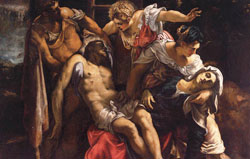Supercharging the Creative Process:
A Roadmap Toward Better Art
Part 8, Creation Ends as it Begins
And so we’ve come full circle, traveling by virtue of a philosophic machine. Welcome back.
But what if we aren’t building a home. What if our chosen field of creativity is another art entirely? Does the philosophic machine still hold true?
The answer of course is yes. Let’s say you are a scriptwriter. So you have to start by dreaming up an objective.
8. We begin our countdown at infinity, drawing information out of the greater body of everything, that we need to begin the process of thought.
7. At the level of thought we examine the facts, we add up pluses and minuses, and look for patterns in the data. We study surveys and statistics, and we engage in analysis and evaluation. Here are the powers of logic applied. Now we have a direction and an idea for our script. Perhaps it is to be a who-done-it.
6. Now we decide where in the world the script must take place. Filmmakers call this the milieu, or social environment. Does the story take place on the open ocean or in Hells Kitchen? In what time does the story takes place? Is this modern time? Is it in the future or distant past. Perhaps it is a who-done-it in the 1200’s! And now we have our playing field.
5. No script can be written without a cast of characters. And so we bring in all the elements of life by casting our players. Who is the good guy (protagonist)? Who is the bad (antagonist)? Who will have supporting roles? What friends do they have? These are the players on the playing field and in opposing teams.
4. But what drives them? Scriptwriting books mistakenly believe conflict drives the story, but you can’t work with that. If you don’t believe me, just try to write a story based on conflict. Conflict doesn’t drive anything. Objectives drive things. People can have conflicting objectives—that is the nature of a game. So here at this level of unifying themes, we have the name of the game. Consider the incredible theme of To Kill a Mockingbird dealing with the progression from innocence to the appreciation of the blend of good and evil in people and the ultimate ability to confront evil without losing faith in the basic goodness of humanity. And we have other unifying factors such as art motif. In The Matrix the art motif was the color green. And we also have genre to consider: Is this to be a comedy? A drama? A tragedy? And further, will this film be fit for the whole family with a G rating? Or will it be PG or R rated? Any work of art may have multiple unifying elements.
3. Now we move into the realm of organization. Games are composed of three things: purposes, freedoms and barriers. So how does the story play out. And so, at this level we have plot. Do we tell the story from beginning to end? Or from end to beginning as in Pulp Fiction? How do we group scenes together? What are the chapters? Do we tell the back story first? Or show the results of it and then reveal the back story later in flashback? These are organizational decisions of sequencing and grouping.
2. Now that our plot stands firm, we reach the level of creativity. We have ideas for costume designs, and we consider the aesthetic sensibilities. Why? Because we want to create a work of art and that means quality. To produce a quality product, we must consider all the parts of the final work and give each part it’s due creative diligence through ornamentation. So we must ornament the script gracing it with personality.
1. Finally at the level of symbols we can start writing. But not a script. First comes an outline, and even before that a treatment in some cases. Here further details of the story are hashed out and discussions are held among fellow creatives.
1. With the outline done, you are ready to write a script, creating the actual object that will be used to shoot the film. This actual object is itself a symbol for the story which will one day exist on film.
2. Next we re-encounter the step of creativity. Yet now others are involved: the director does his treatment of the script and takes over as the guiding force of the film’s creation. The lighting people do their plan. The art director does works out the art motif. The casting people propose actors. The makeup artists do their plan. The sets designers do their part. The location scouts propose their locations. The cameramen workout their camera angles.
3. And then comes organization and that means shooting schedules, cues, people and equipment showing up on time. Film is shot and reviewed. Then the editor organizes the film, grouping shots together to tell a story. Matching sound and music and visuals. Then the film is mastered and copied and sent out.
4. Marketing does their magic and comes up with a creative strategy for the film. This strategy provides a unifying identity for advertising and popularizing the film on the world stage. All PR, advertising and promotion adds up to a single message unifying the film into a cohesive whole.
5. Now again we encounter life as the film is seen by people in theaters and the characters in the film may take on a sort of immortal life of their own.
6. If popular enough, if its message is powerful and well executed, the film continues to move out and becomes an indelible part of the world landscape.
7. And as it does, it contributes to the general body of thought, perhaps causing change within the patterns and ideas that form the matrix of society. Countless examples in history illustrate this exact fact. Can you say, “Renaissance”? Sure, I knew you could.
8. Impacting in many subtle ways, the film leaves its mark on the pages of history and thereby upon the fabric of infinity. Now available for others to draw from when doing their own research and homework in preparation for future productions and works of art.
And with its next tick of our clock, our creative sweep moves from infinity back to zero where the cycle starts anew.


















